1. Radar basics
1. Radar basics1.1. Overview1.2. Silan radar components1.2.1. Laser1.2.2. Receiver1.2.3. Signal processing unit1.2.4. Rotating mechanism1.3. Principle of single-line lidar1.3.1. Trigonometric ranging method1. Direct type2. Oblique shot type1.3.2. TOF time-of-flight ranging method1.4. Lidar A1M81.5. Application scenarios1.6. Function package rplidar ros1.6.1. Remap USB serial port1.6.2. Code testing1.6.3. Map construction test1.7. Source code analysis
Slam lidar tutorial materials: http://www.slamtec.com/cn/Support
Lidar technology email address: support@slamtec.com
Lidar wiki: http://wiki.ros.org/rplidar
LiDAR SDK: https://github.com/Slamtec/rplidar_sdk
LiDAR ROS: https://github.com/Slamtec/rplidar_ros
Lidar tutorial: https://github.com/robopeak/rplidar_ros/wiki
For different models of radar
xxxxxxxxxx#Raspberry Pi 5 master needs to enter docker first, please perform this step#If running the script into docker fails, please refer to ROS/07, Docker tutorial~/run_docker.shBefore using lidar, you need to declare the [RPLIDAR_TYPE] variable in advance in the [.bashrc] file according to different radar models. Open the [.bashrc] file
xxxxxxxxxxsudo vim ~/.bashrc
If there is no sentence below in [.bashrc], you need to add it manually according to the purchased radar model. If there is this sentence, modify the radar model directly. For example: Silan a1 lidar
xxxxxxxxxxexport RPLIDAR_TYPE=a1 # a1, a2, a3, s1, s2Note: For rosmaster series cars equipped with s2l radar, the radar startup method is the same as s2. Just change it to s2 here.
After modification, refresh the environment variables
xxxxxxxxxxsource ~/.bashrc
1.1. Overview
Single-line lidar refers to a radar whose line beam emitted by the laser source is a single line. It can be divided into triangular ranging and TOF lidar. It is mainly used in the field of robotics. It has fast scanning speed, strong resolution and high reliability. Compared with multi-line lidar, single-line lidar responds faster in angular frequency and sensitivity, so it is more accurate in measuring distance and accuracy of obstacles.

1.2. Silan radar components
Taking Silan Technology's single-line lidar as an example, it is mainly composed of four core components: laser, receiver, signal processing unit and rotating mechanism.
RPLIDAR adopts a coordinate system that follows the left-hand rule. The front of the sensor is defined as the x-axis of the coordinate system. The origin of the coordinate system is the rotation center of the ranging core. The rotation angle increases with clockwise rotation. The specific coordinate system definition is shown in the figure below: (For details, please see the supporting manual)
| A1 | A2, A3 |
| :------------------------------------------------ -: | :------------------------------------------------- ---: |
| 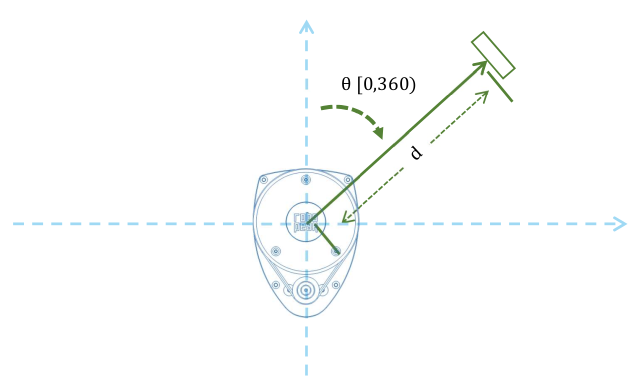 |
| 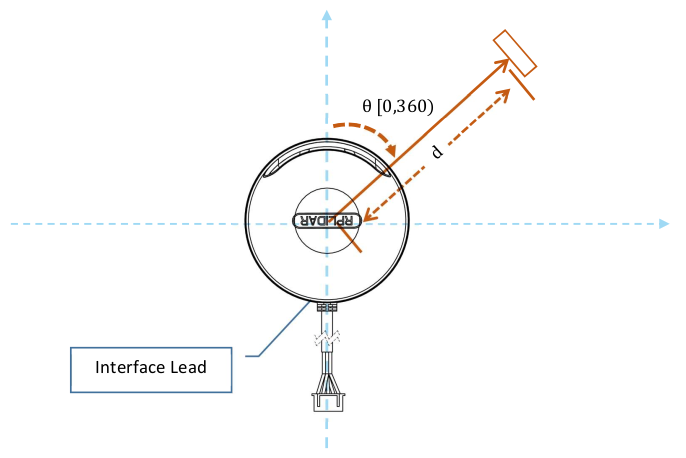 |
| S1 | S2 |
|
|
| S1 | S2 |
| 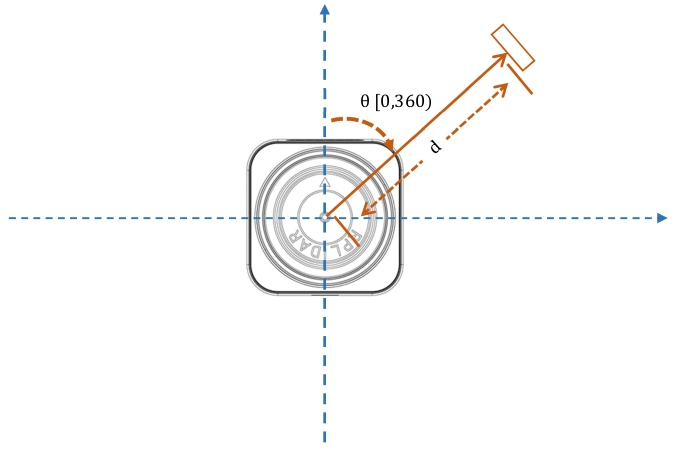 |
| 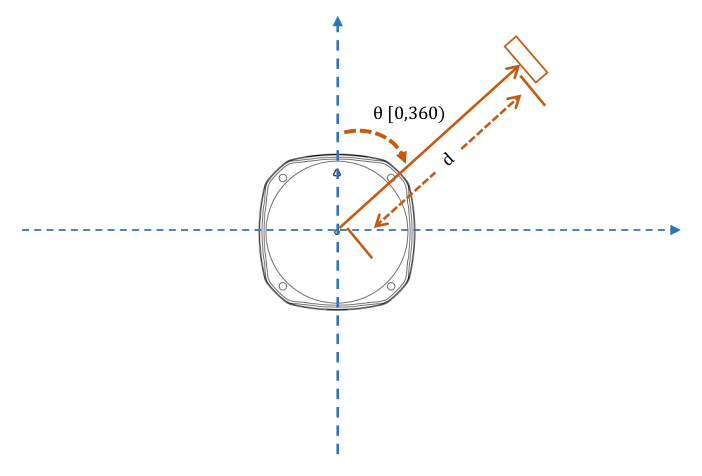 |
|
1.2.1. Laser
The laser is the laser emitting mechanism in lidar. During operation, it lights up in a pulsed manner. Silan Technology's RPLIDAR A3 series radar lights up and goes out 16,000 times per second.
1.2.2. Receiver
After the laser emitted by the laser hits an obstacle, the reflected light will be concentrated on the receiver through the lens group through reflection from the obstacle.
1.2.3. Signal processing unit
The signal processing unit is responsible for controlling the emission of the laser and processing the signals received by the receiver. Based on this information, the distance information of the target object is calculated.
1.2.4. Rotating mechanism
The above three components constitute the core components of measurement. The rotating mechanism is responsible for rotating the above-mentioned core components at a stable speed to scan the plane and generate real-time floor plan information.
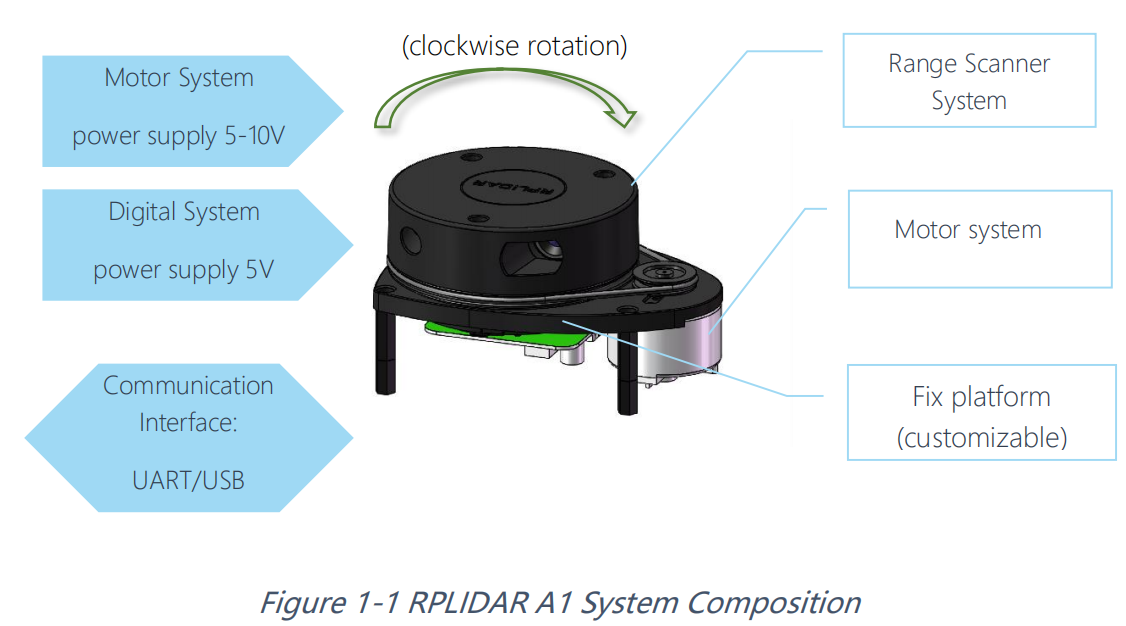
1.3. Principle of single-line lidar
The working principle of the single-wire mechanical rotating radar is as shown in the figure below:
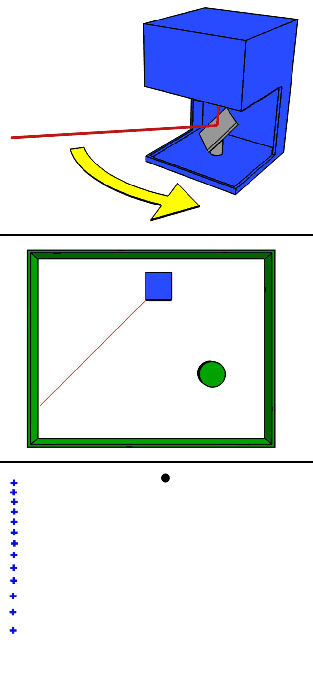
1.3.1. Trigonometric ranging method
The laser triangulation ranging method mainly uses a beam of laser to illuminate the measured target at a certain incident angle. The laser is reflected and scattered on the target surface. At another angle, a lens is used to converge and image the reflected laser. The spot is imaged on the CCD (Charge-coupled Device, photosensitive coupling component) on the position sensor. When the measured object moves along the direction of the laser, the light spot on the position sensor will move, and its displacement corresponds to the movement distance of the measured object. Therefore, the distance between the measured object and the baseline can be calculated from the light spot displacement distance through algorithm design. value. Since the incident light and the reflected light form a triangle, the geometric triangle theorem is used to calculate the spot displacement, so this measurement method is called the laser triangulation ranging method.
According to the angular relationship between the incident beam and the normal line of the surface of the measured object, the laser triangulation ranging method can be divided into two types: oblique type and direct type.
1. Direct type
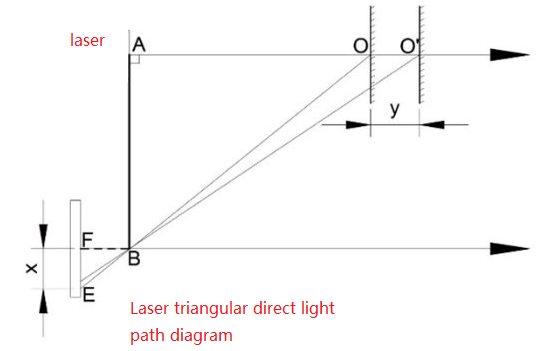
As shown in Figure 1, when the laser beam is vertically incident on the surface of the object to be measured, that is, when the incident light is collinear with the normal line of the surface of the object to be measured, it is a direct laser triangulation method.
2. Oblique shot type
When the angle between the incident laser beam and the normal line of the surface of the object being measured is less than 90° in the optical path system, the incident mode is oblique. The optical path diagram shown in Figure 2 is a laser triangulation oblique optical path diagram.
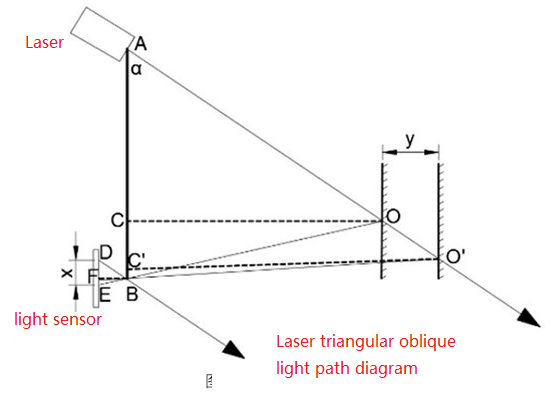
The laser emitted by the laser is incident on the surface of the object being measured at a certain angle with the normal line of the object surface. The reflected (scattered) light is concentrated through the lens at B and is finally collected by the photosensitive unit.
Whether it is the direct or oblique laser triangulation ranging method, it can achieve high-precision, non-contact measurement of the measured object, but the resolution of the direct type is not as high as that of the oblique type.
Silan Technology's RPLIDAR series lidar also uses the oblique laser triangulation ranging method. During each ranging process, the RPLIDAR series lidar will emit a modulated infrared laser signal. The reflection generated by the laser signal after hitting the target object will be received by the RPLIDAR visual acquisition system, and then processed by the DSP embedded inside the RPLIDAR. The device solves the problem in real time, and the distance value between the illuminated target object and the RPLIDAR and the current angle information will be output from the communication interface. Driven by the motor mechanism, the ranging core of RPLIDAR will rotate clockwise, thereby achieving 360-degree all-round scanning and ranging detection of the surrounding environment.
1.3.2. TOF time-of-flight ranging method
TOF lidar is based on measuring the flight time of light to obtain the distance of the target. Its working principle is mainly as follows: a modulated laser signal is emitted through a laser transmitter. The modulated light is received by the laser detector after being reflected by the object being measured. The distance to the target can be calculated by measuring the phase difference between the emitted laser and the received laser. .
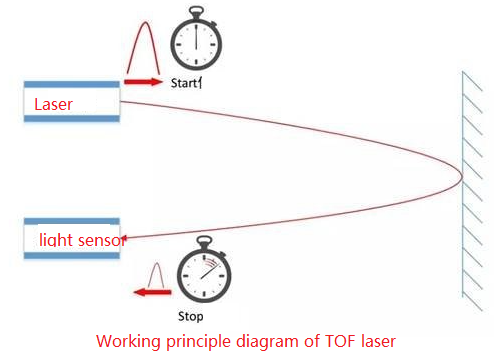
Under the condition of distant objects, its measurement accuracy remains accurate and stable. At the same time, TOF radar is not inferior in its ability to resist light interference due to its ultra-short light pulse characteristics. It can achieve stable ranging and high-precision mapping even under strong light of 60Klx outdoors.
Generally speaking, triangular ranging lidar and TOF lidar have their own difficulties in implementation. In principle, TOF radar has a longer ranging distance. In some occasions where distance is required, TOF radar is the most common, while The manufacturing cost of triangular ranging lidar is relatively low, and its accuracy can meet most industrial-grade civilian requirements, so it has also attracted much attention in the industry.
1.4. Lidar A1M8
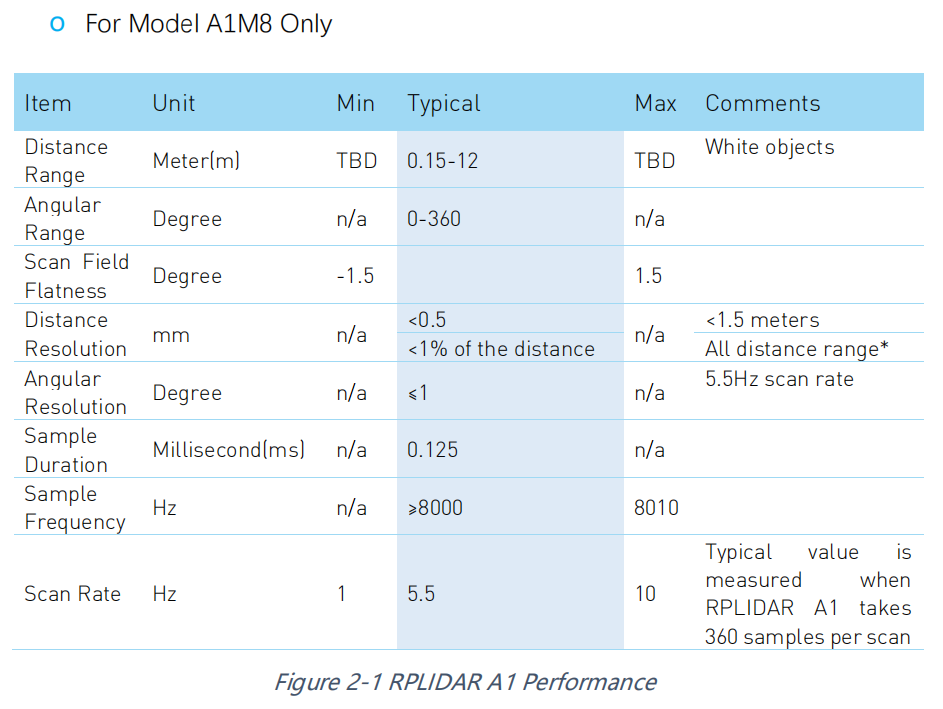
As can be seen from the figure above, parameters such as measurement radius, sampling speed, rotation speed, and angular resolution are important indicators of radar performance.
| Indicator | Description |
|---|---|
| Ranging radius | Radar measuring distance range |
| Ranging sampling rate | How many ranging outputs are performed in one second |
| Scanning frequency | How many times the radar scans in one second |
| Angular resolution | Angle step between two adjacent ranging |
| Measurement resolution/accuracy | Minimum distance change can be perceived |
A higher scanning frequency can ensure that the robot equipped with lidar can move at a faster speed and ensure the quality of map construction. However, increasing the scanning frequency is not as simple as accelerating the rotation of the lidar's internal scanning motor. Correspondingly, it is necessary to increase the ranging sampling rate. Otherwise, when the sampling frequency is fixed, faster scanning speed will only reduce the angular resolution. In addition to ranging distance and scanning frequency, parameters such as measurement resolution and mapping accuracy are equally important to lidar performance. These are important parameters to ensure that the robot can have stable performance.
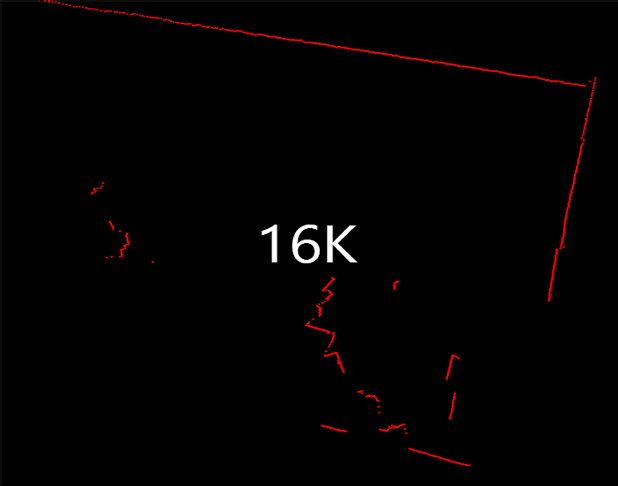
1.5. Application scenarios
Thanks to the advancement of lidar technology, the measurement radius, ranging frequency, distance resolution and angular resolution of lidar have been greatly improved, which can help various applications obtain larger scenes and richer contour information. It plays an indispensable and important role in many fields such as robot autonomous positioning and navigation, space environment surveying and mapping, and security and defense.
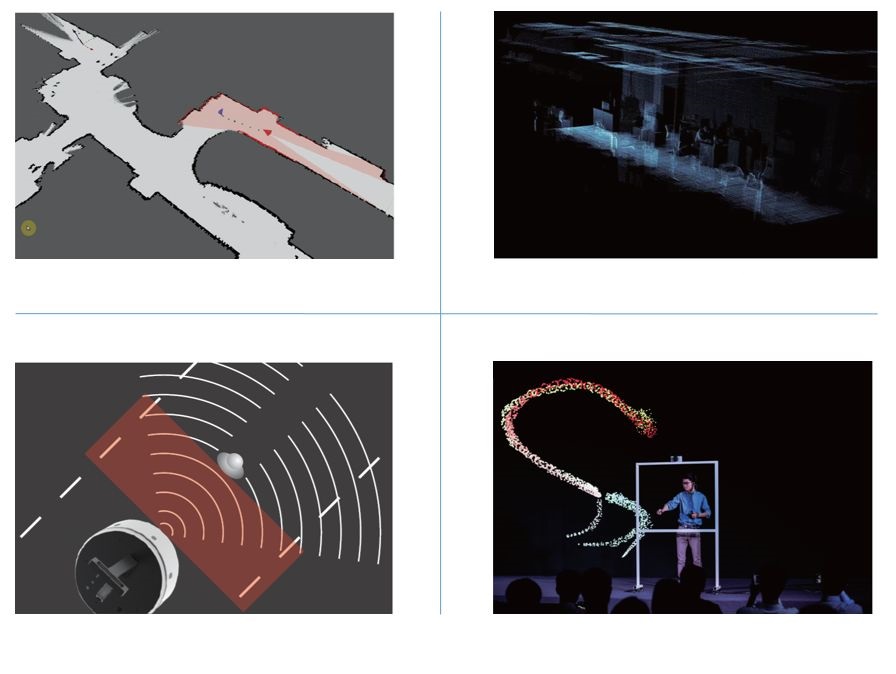
1.6. Function package rplidar ros
Clone this project into the src folder of your workspace and run catkin_make to build rplidarNode and rplidarNodeClient.
1.6.1. Remap USB serial port
When starting the radar function package, you may encounter that the serial port permissions are not executable. There are two solutions: 1) Add permissions directly; 2) Remap the USB serial port
Directly add permission method
This method only works this time.
Check the permissions of rplidar serial port:
xxxxxxxxxxls -l /dev |grep ttyUSB
Add write permission: (such as /dev/ttyUSB0)
xxxxxxxxxxsudo chmod 777 /dev/ttyUSB0
Remapping USB serial port method
This method works long term.
In the rplidar_ros function package path, install USB port remapping
xxxxxxxxxx./scripts/create_udev_rules.sh
Re-plug the LiDAR USB interface and use the following command to modify the remapping:
xxxxxxxxxxls -l /dev | grep ttyUSB

1.6.2. Code testing
Run the rplidar node and view it in rviz
xxxxxxxxxxroslaunch rplidar_ros view_rplidar.launch
You should see rplidar's scan results in rviz.
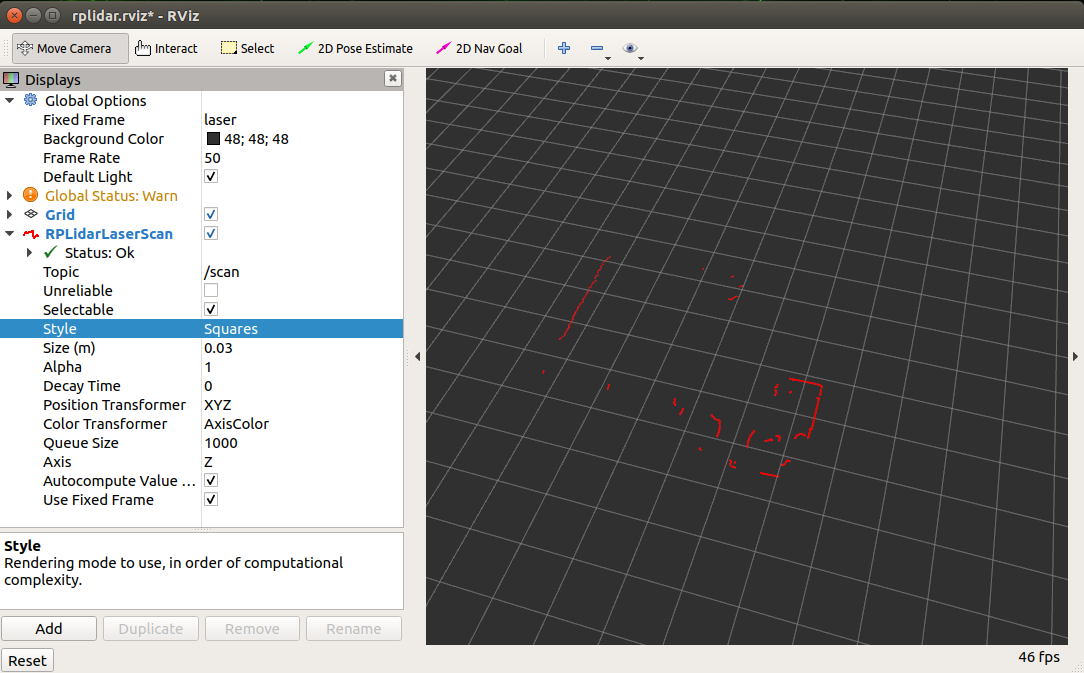
Run the rplidar node and see with the test application
xxxxxxxxxxroslaunch rplidar_ros rplidar.launch # Launch radar<PI5 needs to open another terminal to enter the same docker container
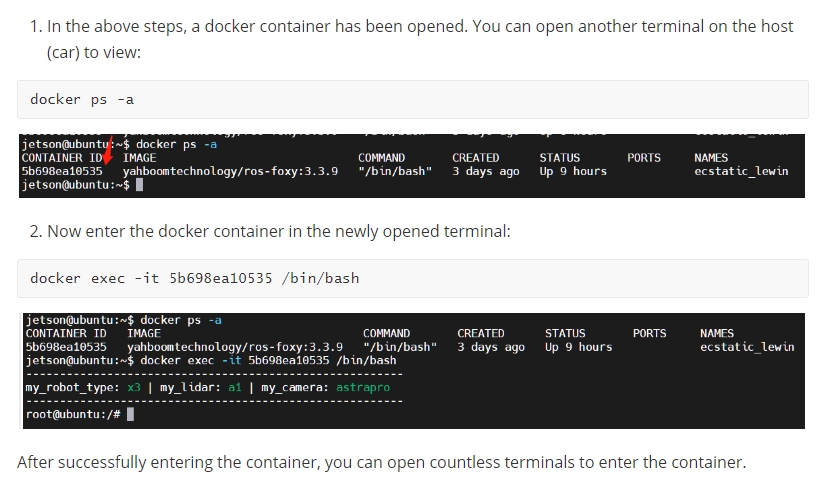
xxxxxxxxxxrosrun rplidar_ros rplidarNodeClient # Get and print radar dataYou should see rplidar's scan results in the console
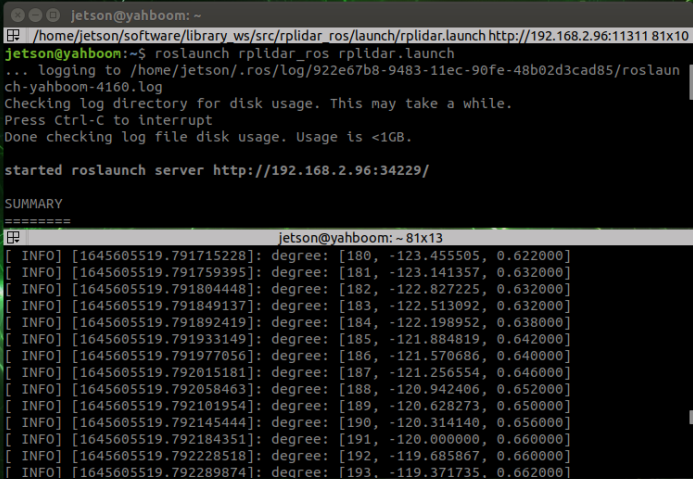
1.6.3. Map construction test
xxxxxxxxxxroslaunch rplidar_ros test_gmapping.launch
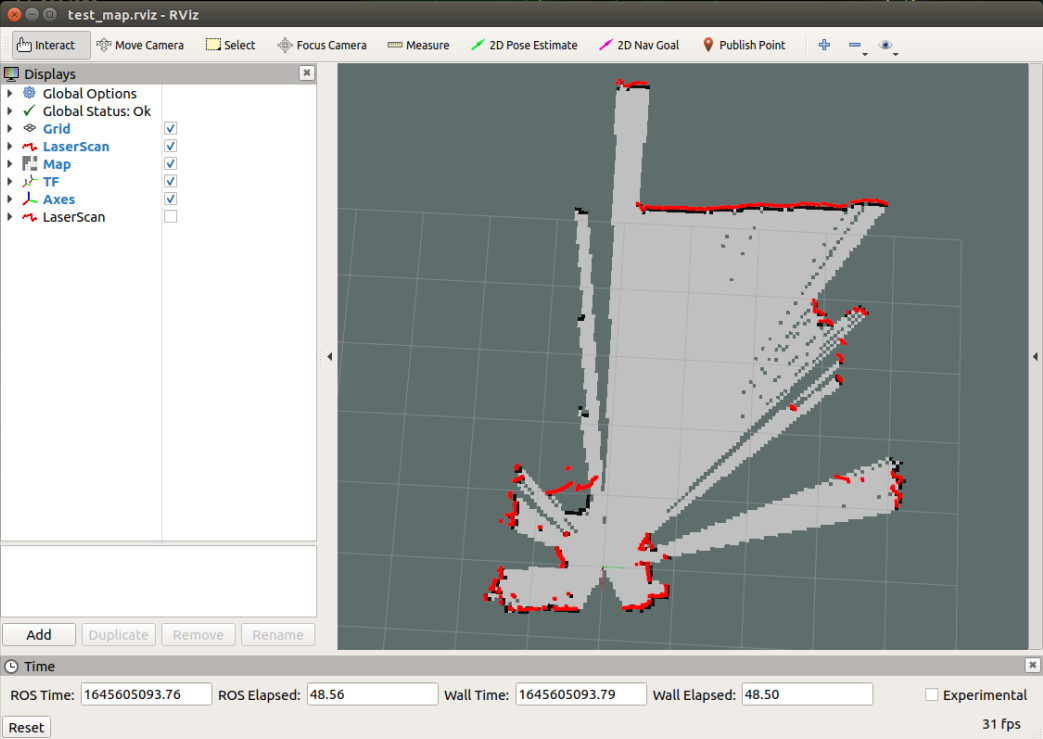
xxxxxxxxxxrosrun rqt_tf_tree rqt_tf_tree
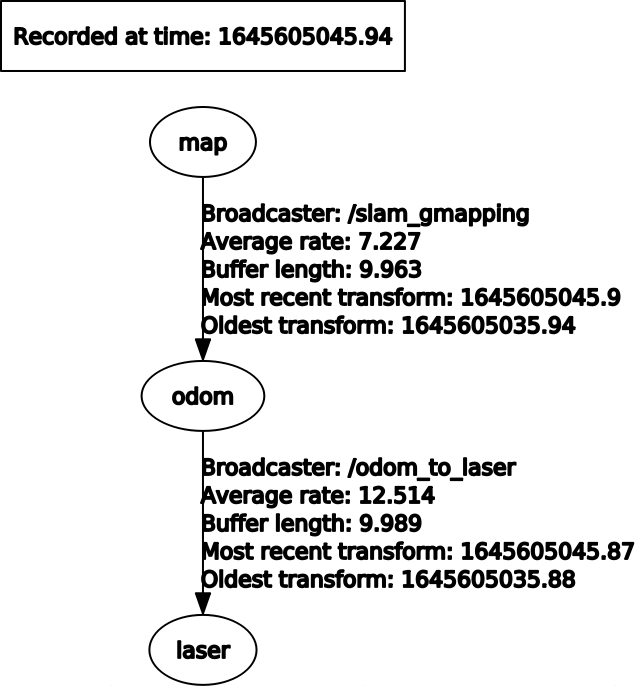
xxxxxxxxxxrosrun rqt_graph rqt_graph

1.7. Source code analysis
From the test in section [1.6], it can be seen that the lidar data does not have 360° data. There is a small gap. That is because the data behind the lidar is blocked.
rplidar.launch file
xxxxxxxxxx<launch> <arg name="lidar_type" value="$(env RPLIDAR_TYPE)" doc="lidar_type type [a1,a2,a3,s1,s2]"/> <arg name="frame_id" default="laser"/> <arg name="shielding_angle" default="30"/> <!-- scan filtering node --> <node name="scan_filter" pkg="rplidar_ros" type="scan_filter.py" output="screen" respawn="true"> <param name="shielding_angle" type="double" value="$(arg shielding_angle)"/> </node> <node name="rplidarNode" pkg="rplidar_ros" type="rplidarNode" output="screen" respawn="true"> <param name="serial_port" type="string" value="/dev/rplidar"/> <param name="serial_baudrate" type="int" value="115200" if="$(eval arg('lidar_type') == 'a1')"/> <param name="serial_baudrate" type="int" value="115200" if="$(eval arg('lidar_type') == 'a2')"/> <param name="serial_baudrate" type="int" value="256000" if="$(eval arg('lidar_type') == 'a3')"/> <param name="serial_baudrate" type="int" value="256000" if="$(eval arg('lidar_type') == 's1')"/> <param name="serial_baudrate" type="int" value="1000000" if="$(eval arg('lidar_type') == 's2')"/> <param name="frame_id" type="string" value="$(arg frame_id)"/> <param name="inverted" type="bool" value="false"/> <param name="angle_compensate" type="bool" value="true"/> <param name="scan_mode" type="string" value="Sensitivity" if="$(eval arg('lidar_type') == 'a3')"/> <param name="scan_mode" type="string" value=" " unless="$(eval arg('lidar_type') == 'a3')"/> <remap from="scan" to="scan_raw"/> </node></launch>shielding_angle parameter: the angle for shielding radar data, range [0, 360], which can be adjusted according to the actual situation.
gmapping is only applicable to points where the number of two-dimensional laser points in a single frame is less than 1440. If the number of laser points in a single frame is greater than 1440, then problems such as [[mapping-4] process has died] will occur. Therefore, when using S2 lidar, the number of S2 points needs to be diluted.
If you do not need to filter radar data, comment or delete the following content in the [rplidar.launch] file
xxxxxxxxxx <!-- scan filtering node --> <node name="scan_filter" pkg="rplidar_ros" type="scan_filter.py" output="screen" respawn="true"> <param name="shielding_angle" type="double" value="$(arg shielding_angle)"/> </node>Then modify the [rplidarNode] node
xxxxxxxxxx<remap from="scan" to="scan_raw"/> <!-- Delete --><remap from="scan" to="scan"/> <!-- Add -->Users can handle it according to the actual situation.